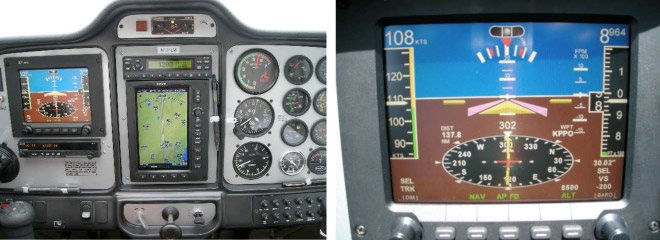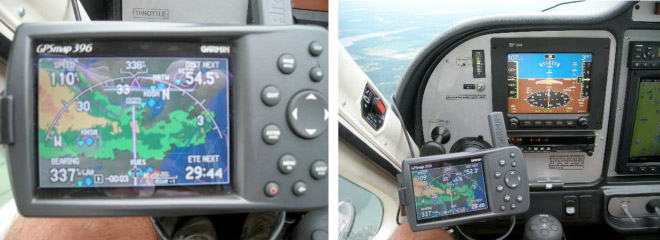"We steadily improve our processes and procedures in order to make our customers ecstatically happy while maintaining the dignity of our entire family of employees".
My Trip to Oshkosh – 2009
By Louis Mancuso
Flying to Oshkosh is like a religious pilgrimage for me – a trip I feel compelled to make each year to renew my spirit at the altar of general aviation. I have flown to Oshkosh about 15 times. Usually, I fly my 1975 Piper Turbo Seneca II with its two new Continental engines, but this time I was asked by Tecnam to bring my 2009 LSA Eaglet to Oshkosh to display it in the Light Sport Aircraft mall at Whitman field.
Can an old pilgrim, like myself, who has become accustomed to cruising at 12,000 feet at 170 knots in his trusty Seneca be up to the challenge of flying a 780 pound Light Sport aircraft over 800 miles from my home base on Long Island, all the way to Oshkosh, Wisconsin?

The Tecnam P92 Eaglet is a high-wing light sport aircraft, with a useful load of 540 lbs. Its Rotax engine burns approximately 5.3 gph while cruising at 116 knots, giving the Eaglet a range of over 500 miles.
The Eaglets are built by Tecnam Aircraft, locate in Naples, Italy. The company is owned by the Pascale family, who have been designing and building airplanes for over 60 years and are well respected all over the world. They are best known in the USA for the Partanavia, a high wing, fixed gear twin Lycoming powered aircraft.
I began my trip to Oshkosh from Long Island’s MacArthur Airport, where the Mancuso family have been running an FBO, Mid Island Air Service, Inc. since 1948, coincidently the same year the Pascale family started Tecnam. My grandparents were born in Naples, so the idea of us importing and selling Tecnam’s light sport aircraft was an obvious choice. My trip to Oshkosh did not start from MacArthur Airport, but actually from Hanover Airport (OFP) in Richmond Virginia. It was there that I met Patrick, the avionics manager from Heart of Virginia Aviation, who installed a new TruTrak EFIS (Electric Flight Information System) with built in autopilot that holds altitude and tracks the GPS course on the eight inch Garmin 695. These are amazing state-of-the-art avionics. The EFIS is simple to use and easy to read. The elliptical heading indicator and flight director are usually found only on very expensive, high end EFIS systems. A interesting feature of the TruTrak EFIS is the ability to change the instrument display to look like conventional "steam gauges" - a plus for pilots who are more comfortable with the traditional, round dial displays.

The TruTrak EFIS autopilot follows the pink course line on the Garmin 695 oversized GPS. The altitude hold is activated with the push of a button located next to the big knob on the right side, which also sets your altimeter and rate of climb. The big knob on the left side sets the heading when a green triangle appears on the very cool elliptical heading indicator. When you push the NAV button, the green triangle disappears and the autopilot follows the GPS course. You can also bring up a Flight Director by holding down the FD button for two seconds...how cool it that.
After completing a through briefing with Patrick, I filled the tanks with 24 gallons of fuel and set off to Oshkosh. The first leg of my journey would be Ohio State University Airport (OSU), in Columbus, OH. I left Hanover Airport at 3:30 pm and climbed to 10,500 feet in 14 minutes, averaging about 700 fpm. The climb rates of many of the new LSA’s, such as the Eaglet, are very impressive due to their large and high lift wing designs. Once established in cruise, I easily programmed the TruTrak EFIS with a push of a few buttons, setting a course to Ohio State University Airport. I set the Rotax power plant for 5300 RPM, which is about 80% power. At this power setting, the engine CHT was showing a very cool 160 degrees versus the usual 375 degrees in my Seneca. The oil temps were at 170 degrees, which is hot enough to burn off any impurities in the oil. Oil pressure was a strong 65 PSI and the volt meter showed 14 amps, confirming the internal engine stator was putting out plenty of electric output. What is an internal engine stator, you might ask? The Rotax does not use a traditional alternator, but rather a built-in stator that produces its own electricity. The benefit of the stator is dependable, low-cost, low-weight electrical power without the weight or problems associated with alternators. There are no belts or alternator brackets to fail or break.
I was indicating 96 knots, and a true airspeed of about 113 knots. I had a slight headwind so my groundspeed was about 100 knots. Even with the headwind, the Eaglets 24 gallons would be sufficient to take me the 300 miles to Ohio State University Airport, as the fuel burn is only 5.3 GPH for the Rotax at cruise power. My flight plan was going to put me in the EVERS MOA which had a floor of 1000 feet and a top of 18000 feet. I placed the cursor on the edge of the MOA and the Garmin 695 drew a new pink line that would take me around the MOA. The TruTrak followed the course correction and around the MOA I went.
I was curious as to how accurate the Eaglet’s published service ceiling of 14,000 feet was, so I decided to climb and see how high I could fly. At 12,500 feet I put on my oxygen mask and kept climbing. At 15,600 feet I was still climbing at 300 FPM, but I decided that was high enough. My indicated airspeed at 15,600 was only 75 knots and my ground speed was 87 knots, so I descended back down to 10,500.
I arrived at Ohio State University Airport at 6:30 pm having made the 300 nautical miles in 3 hours. My fuel burn was 16.2 gallons, for an average of 5.4 GPH. I still had over 7 gallons fuel remaining, about 1:30 hours of cruise flight, which was three times the legal VFR reserve of 30 minutes, and comfortably more than my personal limit of at least 1 hour of fuel..
The next day, I got ready for my final leg to Oshkosh. I went online and read about the Oshkosh arrival procedures. On previous trips to Oshkosh, I had always avoided landing right at Whitman field and preferred landing at neighboring airports such as Green Bay, Appleton, or Fond Du Lac. This time, my Eaglet would be on display in the LSA mall, so I needed to land at Whitman. The instructions said to fly to the town of Ripon at 1100 feet. Upon arrival at Ripon, slow to 90 knots and follow another aircraft of similar speed. Make a 45 degree right turn and follow the railroad tracks to Fiske. Planes that could not slow to 90 knots would fly at 1800 feet.
So off to Oshkosh I went. The trip would be approximately 340 NMs, well within the fuel range of the Eaglet. The online briefing said I should expect delays and should plan accordingly to arrive with plenty of fuel. I decided a stop in LaPorte, Indiana would be prudent. There, I could get some 91 octane auto fuel. The Rotax engine actually prefers auto fuel as it does not have the lead content of 100 LL. My stop in LaPorte was uneventful. As I planned my final leg into Oshkosh, I realized the weather might be a problem. Inclement weather had developed between me and Oshkosh. Luckily my portable Garmin 396 is equipped with XM weather. I decided I take off and see how close to Oshkosh I could get monitoring the weather on the Garmin and Flight Service.
.

As I got close to Oshkosh, here is what I saw on the XM weather. The screen was nasty. I had never flown through any yellow weather display, which usually indicates moderate turbulence and heavy rain.
You can also see Oshkosh is only 54.5 miles ahead and there is a blue triangle next to it, which means the weather at Oshkosh is VFR. I decided to press on, but prepared to turn around or divert if the weather would not allow me to maintain VFC. The next photo shows the actual weather out the front windshield of the plane. As you can see, I was 3000 feet and the visibility was at least 8 miles.
To my pleasant surprise, the ceiling and visibility remained very good and the arrival at Ripon was uneventful. Since the weather forecast was predicting IFR conditions, there was only one plane at Ripon when I arrived, so the Ripon to Friske procedure was simple. I followed the railroad to Friske, while monitoring the published tower frequency. When I arrived at Friske, the Tower told me to rock my wings, declared a nice rock, and told me to head east down Friske avenue for a landing on runway 18. When on a downwind for 18 the tower said to land on the blue dot. At Oshkosh there were four dots on the runway, each a different color and planes were landing at the same time and on different dots, pretty amazing!
Once I landed, I put a sign in the window that said "LSA MALL" so the ground personal could direct me to the proper area. I arrived at Oshkosh two days before the official start of AirVentures 2009, so they let me taxi down the street right to the mall. During the show, we sold the Eaglet to a grandfather who lives in Sacramento, CA. He is planning to teach his grandchildren how to fly. My chief LSA instructor, Mike Bellenir delivered the Eaglet to Sacramento in two and a half days. While at the show I purchased another light sport aircraft, a SportCruiser and flew it back home to MacArthur Airport on Long Island. That is another interesting story for another time. I hope you enjoyed the saga of "My Trip to Oshkosh in 2009".
Happy Flying,
Lou Mancuso


